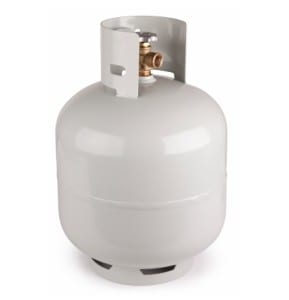For approximately twenty years, home-use propane cylinders have been equipped with valves that contain six very important safety features:
1. Gas service valve to manually open and close the flow path from cylinder to appliance.
2. Pressure relief valve which vents a small amount of gaseous propane if the internal cylinder pressure exceeds a safe value (to prevent catastrophic cylinder rupture).
3. Bleeder valve (+ dip tube) to provide visual indication (white mist) during filling when liquid propane level inside the cylinder reaches its safe upper limit (i.e., overfilling is imminent).
4. Overfill protection device (OPD) which functions to halt liquid inflow to a cylinder when liquid propane level inside the cylinder reaches its safe upper limit.
5. Automatic shutoff valve which prevents gas flow out of the cylinder when the hose to the appliance is not fully connected to the cylinder nozzle.
6. Excess flow valve which halts propane flow out of the cylinder when the flow rate is excessive (e.g., after a catastrophic hose failure).

This author has investigated multiple cases where propane releases and flash fires were caused when the safeguards failed to function as they were intended.
The underlying hazards that create the need for the safeguards are:
1. Gas service valve. The user should be able to exercise control over the flow of propane to the appliance.
2. Pressure relief valve. The cylinder may be subjected to excessive internal pressure for either of two reasons: (a) if the cylinder is overfilled at room temperature and is later exposed to mildly higher temperatures (+25 degrees F or higher), the propane liquid can expand and create unsafe internal pressures; or (b) if the cylinder is filled to a safe level (i.e., approximately 20% vapor space above the liquid) and is later subjected to excessive heating from a fire, the liquid+vapor mixture can reach an unsafe pressure. In either case, the pressure relief valve’s job is to reduce the internal pressure by venting a small amount of the propane vapor until the internal pressure declines to a safer level. This safeguard helps prevent internal pressures that can cause the cylinder to rupture catastrophically.
3. Bleeder valve (+ dip tube). The bleeder valve and dip tube help the filling attendant visibly see when the liquid propane level in the cylinder has reached its maximum safe level (see 2 above). When the tiny stream of propane exiting the bleeder valve during filling changes from transparent vapor to a white mist, the maximum safe liquid level has been reached and the attendant is warned to stop the filling operation immediately.
4. Overfill protection device (OPD). The OPD is an automatically-actuated valve that is intended to achieve the same outcome as the bleeder valve (i.e., prevention of overfilling the cylinder with liquid), albeit without human intervention. The OPD comprises a toilet-tank style float inside the cylinder that closes off the flow path for liquid to enter the cylinder from the filling pump when the desired safe liquid level (see 2 above) has been reached.
5. Automatic shutoff valve. The Automatic shutoff valve (ASV) is a poppet-style valve that is intended to prevent the flow of propane vapor out of the cylinder until the connector nut has been fully tightened to a gas-tight sealing condition. In principle, an engagement tab inside the connector doesn’t engage the ASV’s spring-loaded isolation component until a satisfactory seal is made between the cylinder nozzle and the threaded connector nut. This is a feature that prevents gas flow out of the cylinder if the service valve is accidentally opened during storage or at any time before the appliance connection is made.
6. Excess flow valve. The Excess flow valve prevents or minimizes propane flow under circumstances where the connector is properly sealed but a downstream component (e.g., hose) fails in a way that fuel may be released to the environment instead of the appliance burner. The feature that carries out this function is a spring-loaded sphere that is normally positioned to permit a normal flow of propane vapor but is relocated to a position where the flow orifice is obstructed by the sphere when the drag force on the sphere exceeds the spring force (i.e., when flow velocity is high).
The subject safeguards (applicable to 20 lb propane cylinders) are described and specified in the CGA V-1 document “Standard for Compressed Gas Cylinder Valve Outlet and Inlet Connections”, specifically under connection style CGA 791.
While there is no doubt that the CGA 791 design has prevented numerous propane releases and injuries since it was first promulgated in 2000, this investigator believes it is inferior in one important way to the CGA 600 design that is currently approved only for small (1 lb) propane cylinders. The inferior feature involves the sealing geometry (radial versus axial) in the two designs, and the 791 design inherently provides a lower level of sealing certainty than the 600 design.
This investigator has opined that the 791 design’s inferior feature constitutes a safety defect if the resultant sealing inadequacy leads to a dangerous release of propane that causes personal injury or property damage.
The purpose of “Investigation Anecdotes” is to inform our readers about the intriguing field of engineering investigations. We hope you are instructed by this content, and we encourage you to contact us if you seek additional information.